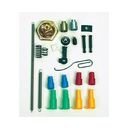Bob J
NES Member
Was working on updating my press (550B) last night and thought the manual detail was a little lite so thought it would be worth starting a thread on Dillon press maintenance.....
Factory manuals can be downloaded from here:
http://www.dillonhelp.com/
Since my press is pretty old I downloaded the latest manual and went through the press part by part against the current configuration..... Lots of changes..... Have built up an upgrade list and will call dillon this PM and order what I need to bring it up to snuff...![Wink [wink] [wink]](/xen/styles/default/xenforo/smilies.vb/002.gif)
Loaded up a small hand oiler with Mobile 1 and placed a small amount around the main shaft..... Really tough to keep it from leaking all over the place but let sit overnight and will clean up when I get off work..... Have moly grease for all the metal to metal bearings and am planning on buying powdered graphite for the slides (primer and powder)....
Bought the wrench set and tool holder... Had all the tools before but this mounts them directly on the press within very easy reach...
http://www.dillonprecision.com/#/co.../Dillon__039_s_RL_550_Toolholder_w_Wrench_Set
What do you guys use to maintain your presses?
Any useful modifications you would like to share?
Factory manuals can be downloaded from here:
http://www.dillonhelp.com/
Since my press is pretty old I downloaded the latest manual and went through the press part by part against the current configuration..... Lots of changes..... Have built up an upgrade list and will call dillon this PM and order what I need to bring it up to snuff...
![Wink [wink] [wink]](/xen/styles/default/xenforo/smilies.vb/002.gif)
Loaded up a small hand oiler with Mobile 1 and placed a small amount around the main shaft..... Really tough to keep it from leaking all over the place but let sit overnight and will clean up when I get off work..... Have moly grease for all the metal to metal bearings and am planning on buying powdered graphite for the slides (primer and powder)....
Bought the wrench set and tool holder... Had all the tools before but this mounts them directly on the press within very easy reach...
http://www.dillonprecision.com/#/co.../Dillon__039_s_RL_550_Toolholder_w_Wrench_Set
What do you guys use to maintain your presses?
Any useful modifications you would like to share?
Last edited:

![Grin [grin] [grin]](/xen/styles/default/xenforo/smilies.vb/041.gif)
![Laugh [laugh] [laugh]](/xen/styles/default/xenforo/smilies.vb/012.gif)
![Smile [smile] [smile]](/xen/styles/default/xenforo/smilies.vb/001.gif)

![Crying [crying] [crying]](/xen/styles/default/xenforo/smilies.vb/006.gif)
![Shocked [shocked] [shocked]](/xen/styles/default/xenforo/smilies.vb/007.gif) To make this worst I found out that these link arm pins (P/N 13834 and P/N 13881) are pressed in and couldn't be backed back out from where I drifted them so I was probably going to do more damage to my ram removing it....[sad2]
To make this worst I found out that these link arm pins (P/N 13834 and P/N 13881) are pressed in and couldn't be backed back out from where I drifted them so I was probably going to do more damage to my ram removing it....[sad2]![Roll Eyes [rolleyes] [rolleyes]](/xen/styles/default/xenforo/smilies.vb/042.gif)